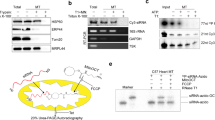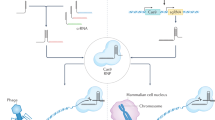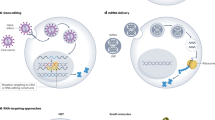Abstract
The discovery of RNA interference (RNAi) may well be one of the transforming events in biology in the past decade. RNAi can result in gene silencing or even in the expulsion of sequences from the genome. Harnessed as an experimental tool, RNAi has revolutionized approaches to decoding gene function. It also has the potential to be exploited therapeutically, and clinical trials to test this possibility are already being planned.
This is a preview of subscription content, access via your institution
Access options
Subscribe to this journal
Receive 51 print issues and online access
$199.00 per year
only $3.90 per issue
Buy this article
- Purchase on Springer Link
- Instant access to full article PDF
Prices may be subject to local taxes which are calculated during checkout



Similar content being viewed by others
References
Fire, A., Albertson, D., Harrison, S. W. & Moerman, D. G. Production of antisense RNA leads to effective and specific inhibition of gene expression in C. elegans muscle. Development 113, 503–514 (1991).
Guo, S. & Kemphues, K. J. par-1, a gene required for establishing polarity in C. elegans embryos, encodes a putative Ser/Thr kinase that is asymmetrically distributed. Cell 81, 611–620 (1995).
Fire, A. et al. Potent and specific genetic interference by double-stranded RNA in Caenorhabditis elegans. Nature 391, 806–811 (1998).
Hannon, G. J. RNA interference. Nature 418, 244–251 (2002).
Williams, B. R. Role of the double-stranded RNA-activated protein kinase (PKR) in cell regulation. Biochem. Soc. Trans. 25, 509–513 (1997).
Bernstein, E., Caudy, A. A., Hammond, S. M. & Hannon, G. J. Role for a bidentate ribonuclease in the initiation step of RNA interference. Nature 409, 363–366 (2001).
Hammond, S. M., Boettcher, S., Caudy, A. A., Kobayashi, R. & Hannon, G. J. Argonaute2, a link between genetic and biochemical analyses of RNAi. Science 293, 1146–1150 (2001).
Elbashir, S. M. et al. Duplexes of 21-nucleotide RNAs mediate RNA interference in cultured mammalian cells. Nature 411, 494–498 (2001).
Hutvágner, G. et al. A cellular function for the RNA-interference enzyme Dicer in the maturation of the let-7 small temporal RNA. Science 293, 834–838 (2001).
Grishok, A. et al. Genes and mechanisms related to RNA interference regulate expression of the small temporal RNAs that control C. elegans developmental timing. Cell 106, 23–34 (2001).
Ketting, R. F. et al. Dicer functions in RNA interference and in synthesis of small RNA involved in developmental timing in C. elegans. Genes Dev. 15, 2654–2659 (2001).
Paddison, P. J., Caudy, A. A., Sachidanandam, R. & Hannon, G. J. Short hairpin activated gene silencing in mammalian cells. Methods Mol. Biol. 265, 85–100 (2004).
Khvorova, A., Reynolds, A. & Jayasena, S. D. Functional siRNAs and miRNAs exhibit strand bias. Cell 115, 209–216 (2003).
Schwarz, D. S. et al. Asymmetry in the assembly of the RNAi enzyme complex. Cell 115, 199–208 (2003).
Reynolds, A. et al. Rational siRNA design for RNA interference. Nature Biotechnol. 22, 326–330 (2004).
Silva, J. M., Sachidanandam, R. & Hannon, G. J. Free energy lights the path toward more effective RNAi. Nature Genet. 35, 303–305 (2003).
Aza-Blanc, P. et al. Identification of modulators of TRAIL-induced apoptosis via RNAi-based phenotypic screening. Mol. Cell 12, 627–637 (2003).
Pebernard, S. & Iggo, R. D. Determinants of interferon-stimulated gene induction by RNAi vectors. Differentiation 72, 103–111 (2004).
Persengiev, S. P., Zhu, X. & Green, M. R. Nonspecific, concentration-dependent stimulation and repression of mammalian gene expression by small interfering RNAs (siRNAs). RNA 10, 12–18 (2004).
Sledz, C. A., Holko, M., de Veer, M. J., Silverman, R. H. & Williams, B. R. Activation of the interferon system by short-interfering RNAs. Nature Cell Biol. 5, 834–839 (2003).
Kim, D. H. et al. Interferon induction by siRNAs and ssRNAs synthesized by phage polymerase. Nature Biotechnol. 22, 321–325 (2004).
Jackson, A. L. et al. Expression profiling reveals off-target gene regulation by RNAi. Nature Biotechnol. 21, 635–637 (2003).
Doench, J. G. & Sharp, P. A. Specificity of microRNA target selection in translational repression. Genes Dev. 18, 504–511 (2004).
Lai, E. C., Tomancak, P., Williams, R. W. & Rubin, G. M. Computational identification of Drosophila microRNA genes. Genome Biol. 4, R42 (2003).
Lewis, B. P., Shih, I. H., Jones-Rhoades, M. W., Bartel, D. P. & Burge, C. B. Prediction of mammalian microRNA targets. Cell 115, 787–798 (2003).
Enright, A. J. et al. MicroRNA targets in Drosophila. Genome Biol. 5, R1 (2003).
Scacheri, P. C. et al. Short interfering RNAs can induce unexpected and divergent changes in the levels of untargeted proteins in mammalian cells. Proc. Natl Acad. Sci. USA 101, 1892–1897 (2004).
McCaffrey, A. P. et al. RNA interference in adult mice. Nature 418, 38–39 (2002).
Matsuda, T. & Cepko, C. L. Electroporation and RNA interference in the rodent retina in vivo and in vitro. Proc. Natl Acad. Sci. USA 101, 16–22 (2004).
Layzer, J. M. et al. In vivo activity of nuclease-resistant siRNAs. RNA 10, 766–771 (2004).
Lewis, D. L., Hagstrom, J. E., Loomis, A. G., Wolff, J. A. & Herweijer, H. Efficient delivery of siRNA for inhibition of gene expression in postnatal mice. Nature Genet. 32, 107–108 (2002).
Sorensen, D. R., Leirdal, M. & Sioud, M. Gene silencing by systemic delivery of synthetic siRNAs in adult mice. J. Mol. Biol. 327, 761–766 (2003).
Brummelkamp, T. R., Bernards, R. & Agami, R. Stable suppression of tumorigenicity by virus-mediated RNA interference. Cancer Cell 2, 243–247 (2002).
Rubinson, D. A. et al. A lentivirus-based system to functionally silence genes in primary mammalian cells, stem cells and transgenic mice by RNA interference. Nature Genet. 33, 401–406 (2003).
Hemann, M. T. et al. An epi-allelic series of p53 hypomorphs created by stable RNAi produces distinct tumor phenotypes in vivo. Nature Genet. 33, 396–400 (2003).
Carmell, M. A., Zhang, L., Conklin, D. S., Hannon, G. J. & Rosenquist, T. A. Germline transmission of RNAi in mice. Nature Struct. Biol. 10, 91–92 (2003).
Tiscornia, G., Singer, O., Ikawa, M. & Verma, I. M. A general method for gene knockdown in mice by using lentiviral vectors expressing small interfering RNA. Proc. Natl Acad. Sci. USA 100, 1844–1848 (2003).
Hasuwa, H., Kaseda, K., Einarsdottir, T. & Okabe, M. Small interfering RNA and gene silencing in transgenic mice and rats. FEBS Lett. 532, 227–230 (2002).
Kunath, T. et al. Transgenic RNA interference in ES cell-derived embryos recapitulates a genetic null phenotype. Nature Biotechnol. 21, 559–561 (2003).
Hsieh, A. C. et al. A library of siRNA duplexes targeting the phosphoinositide 3-kinase pathway: determinants of gene silencing for use in cell-based screens. Nucleic Acids Res. 32, 893–901 (2004).
Brummelkamp, T. R., Nijman, S. M., Dirac, A. M. & Bernards, R. Loss of the cylindromatosis tumour suppressor inhibits apoptosis by activating NF-κB. Nature 424, 797–801 (2003).
Berns, K. et al. A large-scale RNAi screen in human cells identifies new components of the p53 pathway. Nature 428, 431–437 (2004).
Paddison, P. J. et al. A resource for large-scale RNA-interference-based screens in mammals. Nature 428, 427–431 (2004).
Zheng, L. et al. An approach to genomewide screens of expressed small interfering RNAs in mammalian cells. Proc. Natl Acad. Sci. USA 101, 135–140 (2004).
Luo, B., Heard, A. D. & Lodish, H. F. Small interfering RNA production by enzymatic engineering of DNA (SPEED). Proc. Natl Acad. Sci. USA 101, 5494–5499 (2004).
Shirane, D. et al. Enzymatic production of RNAi libraries from cDNAs. Nature Genet. 36, 190–196 (2004).
Sen, G., Wehrman, T. S., Myers, J. W. & Blau, H. M. Restriction enzyme-generated siRNA (REGS) vectors and libraries. Nature Genet. 36, 183–189 (2004).
Silva, J. M., Mizuno, H., Brady, A., Lucito, R. & Hannon, G. J. RNA interference microarrays: high-throughput loss-of-function genetics in mammalian cells. Proc. Natl Acad. Sci. USA 101, 6548–6552 (2004).
Ziauddin, J. & Sabatini, D. M. Microarrays of cells expressing defined cDNAs. Nature 411, 107–110 (2001).
Jacque, J. M., Triques, K. & Stevenson, M. Modulation of HIV-1 replication by RNA interference. Nature 418, 435–438 (2002).
Lee, N. S. et al. Expression of small interfering RNAs targeted against HIV-1 rev transcripts in human cells. Nature Biotechnol. 20, 500–505 (2002).
Coburn, G. A. & Cullen, B. R. Potent and specific inhibition of human immunodeficiency virus type-1 replication by RNA interference. J. Virol. 76, 9225–9231 (2002).
Surabhi, R. M. & Gaynor, R. B. RNA interference directed against viral and cellular targets inhibits human immunodeficiency virus type-1 replication. J. Virol. 76, 12963–12973 (2002).
Novina, C. D. et al. siRNA-directed inhibition of HIV-1 infection. Nature Med. 8, 681–686 (2002).
Park, W. S. et al. Prevention of HIV-1 infection in human peripheral blood mononuclear cells by specific RNA interference. Nucleic Acids Res. 30, 4830–4835 (2002).
Boden, D., Pusch, O., Lee, F., Tucker, L. & Ramratnam, B. Human immunodeficiency virus type-1 escape from RNA interference. J. Virol. 77, 11531–11535 (2003).
Martinez, M. A. et al. Suppression of chemokine receptor expression by RNA interference allows for inhibition of HIV-1 replication. AIDS 16, 2385–2390 (2002).
Capodici, J., Kariko, K. & Weissman, D. Inhibition of HIV-1 infection by small interfering RNA-mediated RNA interference. J. Immunol. 169, 5196–5201 (2002).
Banerjea, A. et al. Inhibition of HIV-1 by lentiviral vector-transduced siRNAs in T lymphocytes differentiated in SCID-hu mice and CD34+ progenitor cell-derived macrophages. Mol. Ther. 8, 62–71 (2003).
Li, M. J. et al. Inhibition of HIV-1 infection by lentiviral vectors expressing Pol III-promoted anti-HIV RNAs. Mol. Ther. 8, 196–206 (2003).
Eugen-Olsen, J. et al. Heterozygosity for a deletion in the CKR-5 gene leads to prolonged AIDS-free survival and slower CD4 T-cell decline in a cohort of HIV-seropositive individuals. AIDS 11, 305–310 (1997).
Samson, M. et al. Resistance to HIV-1 infection in caucasian individuals bearing mutant alleles of the CCR-5 chemokine receptor gene. Nature 382, 722–725 (1996).
Qin, X. F., An, D. S., Chen, I. S. & Baltimore, D. Inhibiting HIV-1 infection in human T cells by lentiviral-mediated delivery of small interfering RNA against CCR5. Proc. Natl Acad. Sci. USA 100, 183–188 (2003).
Dell'Agnola, C. et al. In vitro and in vivo hematopoietic potential of human stem cells residing in muscle tissue. Exp. Hematol. 30, 905–914 (2002).
Dropulic, B. Lentivirus in the clinic. Mol. Ther. 4, 511–512 (2001).
Davis, B. M., Humeau, L. & Dropulic, B. In vivo selection for human and murine hematopoietic cells transduced with a therapeutic MGMT lentiviral vector that inhibits HIV replication. Mol. Ther. 9, 160–172 (2004).
Amado, R. G. et al. Anti-human immunodeficiency virus hematopoietic progenitor cell-delivered ribozyme in a phase I study: myeloid and lymphoid reconstitution in human immunodeficiency virus type-1-infected patients. Hum. Gene Ther. 15, 251–262 (2004).
Michienzi, A. et al. RNA-mediated inhibition of HIV in a gene therapy setting. Ann. NY Acad. Sci. 1002, 63–71 (2003).
McCaffrey, A. P. et al. Inhibition of hepatitis B virus in mice by RNA interference. Nature Biotechnol. 6, 639–644 (2003).
Blight, K. J., Kolykhalov, A. A. & Rice, C. M. Efficient initiation of HCV RNA replication in cell culture. Science 290, 1972–1974 (2000).
Lohmann, V. et al. Replication of subgenomic hepatitis C virus RNAs in a hepatoma cell line. Science 285, 110–113 (1999).
Ikeda, M., Yi, M., Li, K. & Lemon, S. M. Selectable subgenomic and genome-length dicistronic RNAs derived from an infectious molecular clone of the HCV-N strain of hepatitis C virus replicate efficiently in cultured Huh7 cells. J. Virol. 76, 2997–3006 (2002).
Pietschmann, T., Lohmann, V., Rutter, G., Kurpanek, K. & Bartenschlager, R. Characterization of cell lines carrying self-replicating hepatitis C virus RNAs. J. Virol. 75, 1252–1264 (2001).
Randall, G., Grakoui, A. & Rice, C. M. Clearance of replicating hepatitis C virus replicon RNAs in cell culture by small interfering RNAs. Proc. Natl Acad. Sci. USA 100, 235–240 (2003).
Wilson, J. A. et al. RNA interference blocks gene expression and RNA synthesis from hepatitis C replicons propagated in human liver cells. Proc. Natl Acad. Sci. USA 100, 2783–2788 (2003).
Kapadia, S. B., Brideau-Andersen, A. & Chisari, F. V. Interference of hepatitis C virus RNA replication by short interfering RNAs. Proc. Natl Acad. Sci. USA 100, 2014–2018 (2003).
Song, E. et al. RNA interference targeting Fas protects mice from fulminant hepatitis. Nature Med. 9, 347–351 (2003).
Eastman, S. J. et al. Development of catheter-based procedures for transducing the isolated rabbit liver with plasmid DNA. Hum. Gene Ther. 13, 2065–2077 (2002).
Kittler, R. & Buchholz, F. RNA interference: gene silencing in the fast lane. Semin. Cancer Biol. 13, 259–265 (2003).
Wall, N. R. & Shi, Y. Small RNA: can RNA interference be exploited for therapy? Lancet 362, 1401–1403 (2003).
Lu, P. Y., Xie, F. Y. & Woodle, M. C. siRNA-mediated antitumorigenesis for drug target validation and therapeutics. Curr. Opin. Mol. Ther. 5, 225–234 (2003).
Buchele, T. Proapoptotic therapy with oblimersen (bcl-2 antisense oligonucleotide)—review of preclinical and clinical results. Onkologie 26, (Suppl. 7), 60–69 (2003).
Chiu, Y. L. & Rana, T. M. siRNA function in RNAi: a chemical modification analysis. RNA 9, 1034–1048 (2003).
Czauderna, F. et al. Structural variations and stabilising modifications of synthetic siRNAs in mammalian cells. Nucleic Acids Res. 31, 2705–2716 (2003).
Wang, L., Prakash, R. K., Stein, C. A., Koehn, R. K. & Ruffner, D. E. Progress in the delivery of therapeutic oligonucleotides: organ/cellular distribution and targeted delivery of oligonucleotides in vivo. Antisense Nucleic Acid Drug Dev. 13, 169–189 (2003).
Holtz, M. S. & Bhatia, R. Effect of imatinib mesylate on chronic myelogenous leukemia hematopoietic progenitor cells. Leuk. Lymphoma 45, 237–245 (2004).
Tauchi, T. & Ohyashiki, K. Molecular mechanisms of resistance of leukemia to imatinib mesylate. Leuk. Res. 28 (Suppl. 1), 39–45 (2004).
Cowan-Jacob, S. W. et al. Imatinib (STI571) resistance in chronic myelogenous leukemia: molecular basis of the underlying mechanisms and potential strategies for treatment. Mini Rev. Med. Chem. 4, 285–299 (2004).
Marcucci, G., Perrotti, D. & Caligiuri, M. A. Understanding the molecular basis of imatinib mesylate therapy in chronic myelogenous leukemia and the related mechanisms of resistance. Commentary. Clin. Cancer Res., 9: 1333–1337, 2003. Clin. Cancer Res. 9, 1248–1252 (2003).
Li, M. J., McMahon, R., Snyder, D. S., Yee, J. K. & Rossi, J. J. Specific killing of Ph+ chronic myeloid leukemia cells by a lentiviral vector-delivered anti-bcr/abl small hairpin RNA. Oligonucleotides 13, 401–409 (2003).
Wohlbold, L. et al. Inhibition of bcr-abl gene expression by small interfering RNA sensitizes for imatinib mesylate (STI571). Blood 102, 2236–2239 (2003).
Scherr, M. et al. Specific inhibition of bcr-abl gene expression by small interfering RNA. Blood 101, 1566–1569 (2003).
Miller, V. M., Gouvion, C. M., Davidson, B. L. & Paulson, H. L. Targeting Alzheimer's disease genes with RNA interference: an efficient strategy for silencing mutant alleles. Nucleic Acids Res. 32, 661–668 (2004).
Miller, V. M. et al. Allele-specific silencing of dominant disease genes. Proc. Natl Acad. Sci. USA 100, 7195–7200 (2003).
Ding, H. et al. Selective silencing by RNAi of a dominant allele that causes amyotrophic lateral sclerosis. Aging Cell 2, 209–217 (2003).
Davidson, B. L. & Paulson, H. L. Molecular medicine for the brain: silencing of disease genes with RNA interference. Lancet Neurol. 3, 145–149 (2004).
Pasquinelli, A. E. MicroRNAs: deviants no longer. Trends Genet. 18, 171–173 (2002).
Moss, E. G. MicroRNAs: hidden in the genome. Curr. Biol. 12, R138–R140 (2002).
Hutvágner, G., Simard, M. J., Mello, C. C. & Zamore, P. D. Sequence-specific inhibition of small RNA function. PLoS Biol. 2, E98 (2004).
Saxena, S., Jonsson, Z. O. & Dutta, A. Small RNAs with imperfect match to endogenous mRNA repress translation. Implications for off-target activity of small inhibitory RNA in mammalian cells. J. Biol. Chem. 278, 44312–44319 (2003).
Acknowledgements
We thank members of the RNAi community for making this an exciting field of research. G.J.H. thanks F. Rivas for comments on the manuscript and J. Duffy for help with the figures. J.J.R. thanks L. Scherer for suggestions on therapeutic applications of RNAi. G.J.H. is supported by an Innovator award from the US Army Breast Cancer Research Program and by grants from the NIH. J.J.R. is supported by grants from the NIH, NIAID and NHBLI.
Author information
Authors and Affiliations
Ethics declarations
Competing interests
The authors declare no competing financial interests.
Rights and permissions
About this article
Cite this article
Hannon, G., Rossi, J. Unlocking the potential of the human genome with RNA interference. Nature 431, 371–378 (2004). https://doi.org/10.1038/nature02870
Published:
Issue Date:
DOI: https://doi.org/10.1038/nature02870
This article is cited by
-
Small interfering RNA (siRNA)-based therapeutic applications against viruses: principles, potential, and challenges
Journal of Biomedical Science (2023)
-
Impact of silencing eEF2K expression on the malignant properties of chordoma
Molecular Biology Reports (2023)
-
Editing out HIV: application of gene editing technology to achieve functional cure
Retrovirology (2021)
-
Evaluation of a resorufin-based fluorescent probe for tyrosinase detection in skin pigmentation disorders
Bio-Design and Manufacturing (2021)
-
Targeting EphA2 in cancer
Journal of Hematology & Oncology (2020)
Comments
By submitting a comment you agree to abide by our Terms and Community Guidelines. If you find something abusive or that does not comply with our terms or guidelines please flag it as inappropriate.



